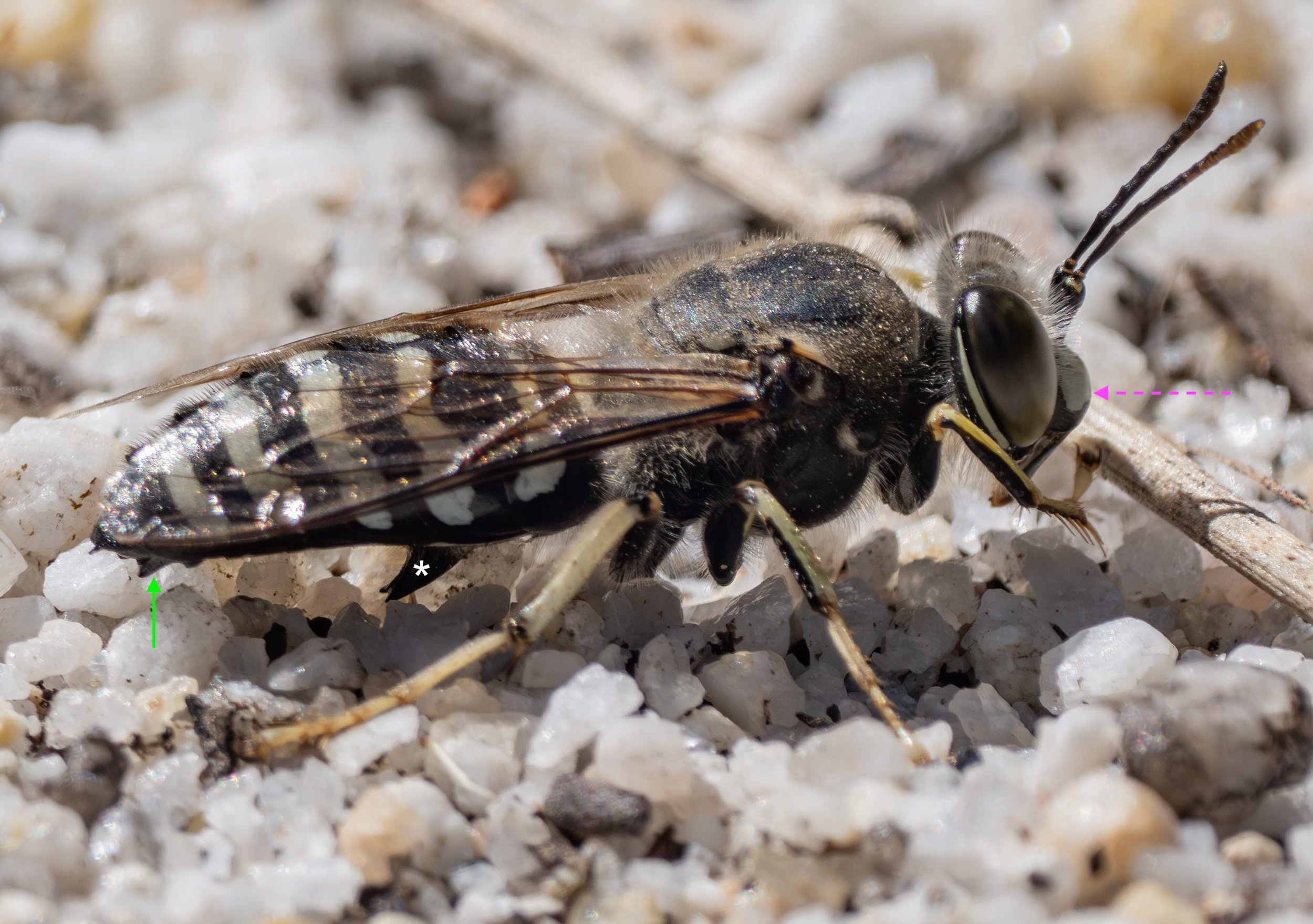
sternal processes of male
Males in some species have distinctive midline processes on the second sternite (S2) (star) and often also on the sixth (S6) (solid arrow). In Bembix furcata, these processes are quite diagnostic. Although this would seem to makes species ID trivial for male B. furcata, there are two complications. First, these processes can be greatly reduced in some individuals, and S2 not apparently bifid, particularly in small males. Second, to see these processes (or the sternites at all), requires a nearly lateral or (ideally) ventral view. Most photos are taken from above.
The lateral view of the clypeus in this male matches the description for Bembix furcata: strongly protruberant, evenly arched in profile (dotted arrow).
Bembix furcata
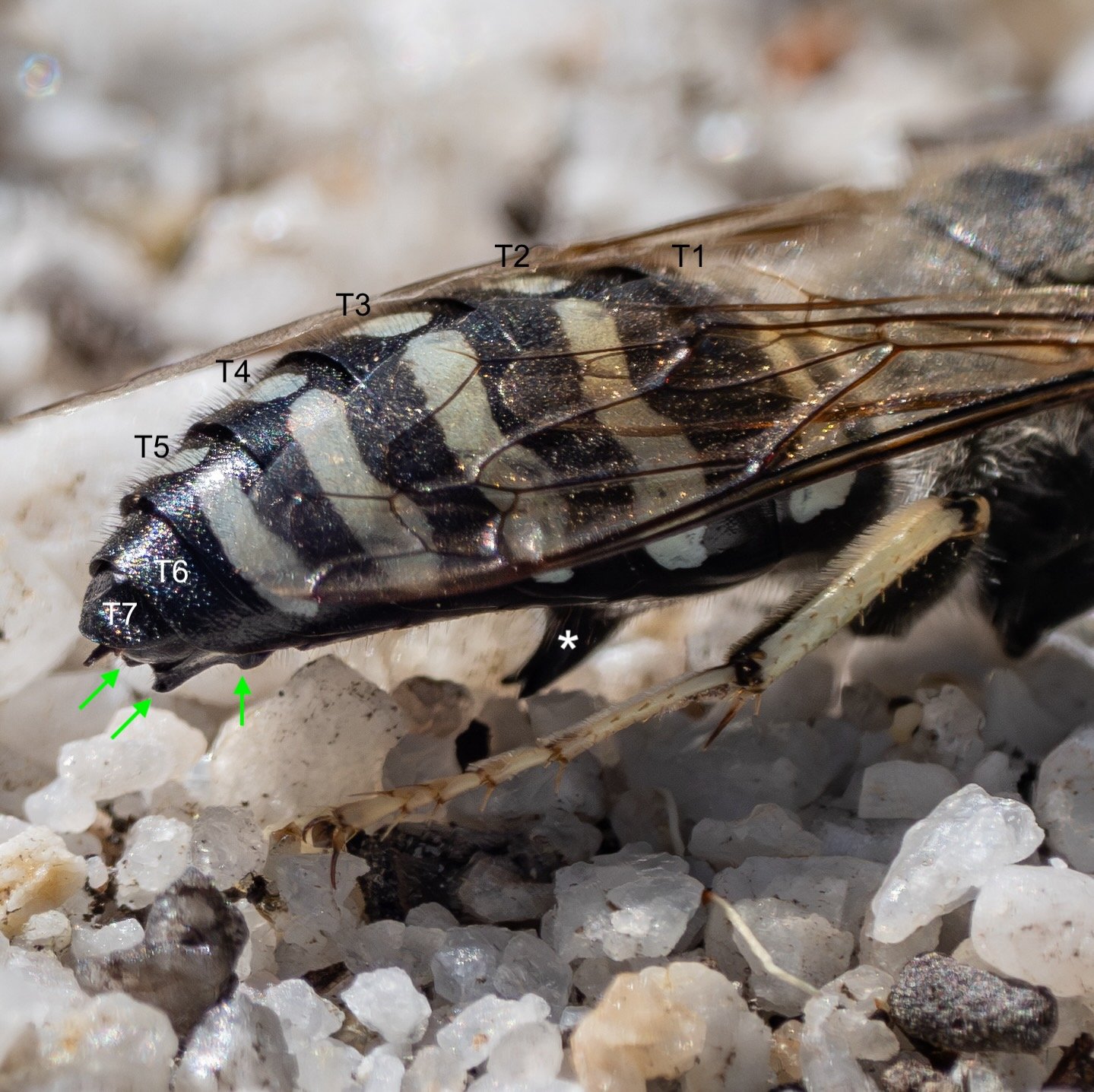
metasomal tergites
In Bembix furcata males, S2 is strongly projecting (star) and often apically cleft to form two points (‘bifid’); S6 has a broad and complex projection (arrows), including a pair of angles at the outer sides and a short, blunt apicomedial point.
Male and female Bembix are best distinguished on the basis of the number of metasomal segments visible dorsally. That is, a count of the tergites. Males have 7, females just 6. Antennae also differ in the number of flagellar segments (males with 11, females with 10). However, apical segments are often short and may be difficult to count accurately in many field photos.
Bembix furcata
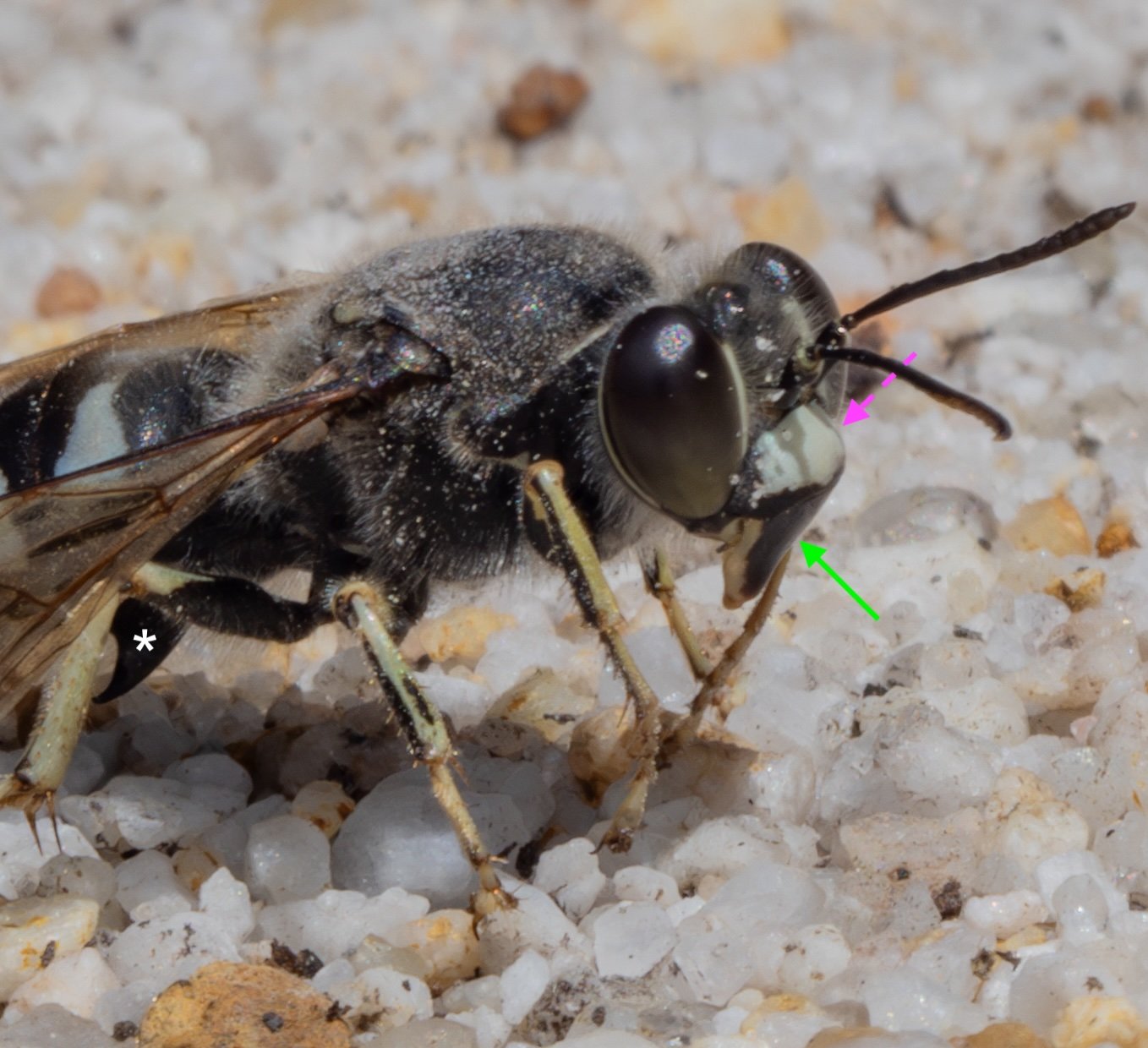
clypeus, labrum, S2 process
In this male the clypeus (dotted pink arrow) is protruding and largely white, although black laterally and apically; the labrum (solid green arrow) largely black, but white-cream laterally. The mandible is pale in colour, the base just visible tucked in behind the labrum.
Note also the large, arched process on S2 (star).
Bembix furcata
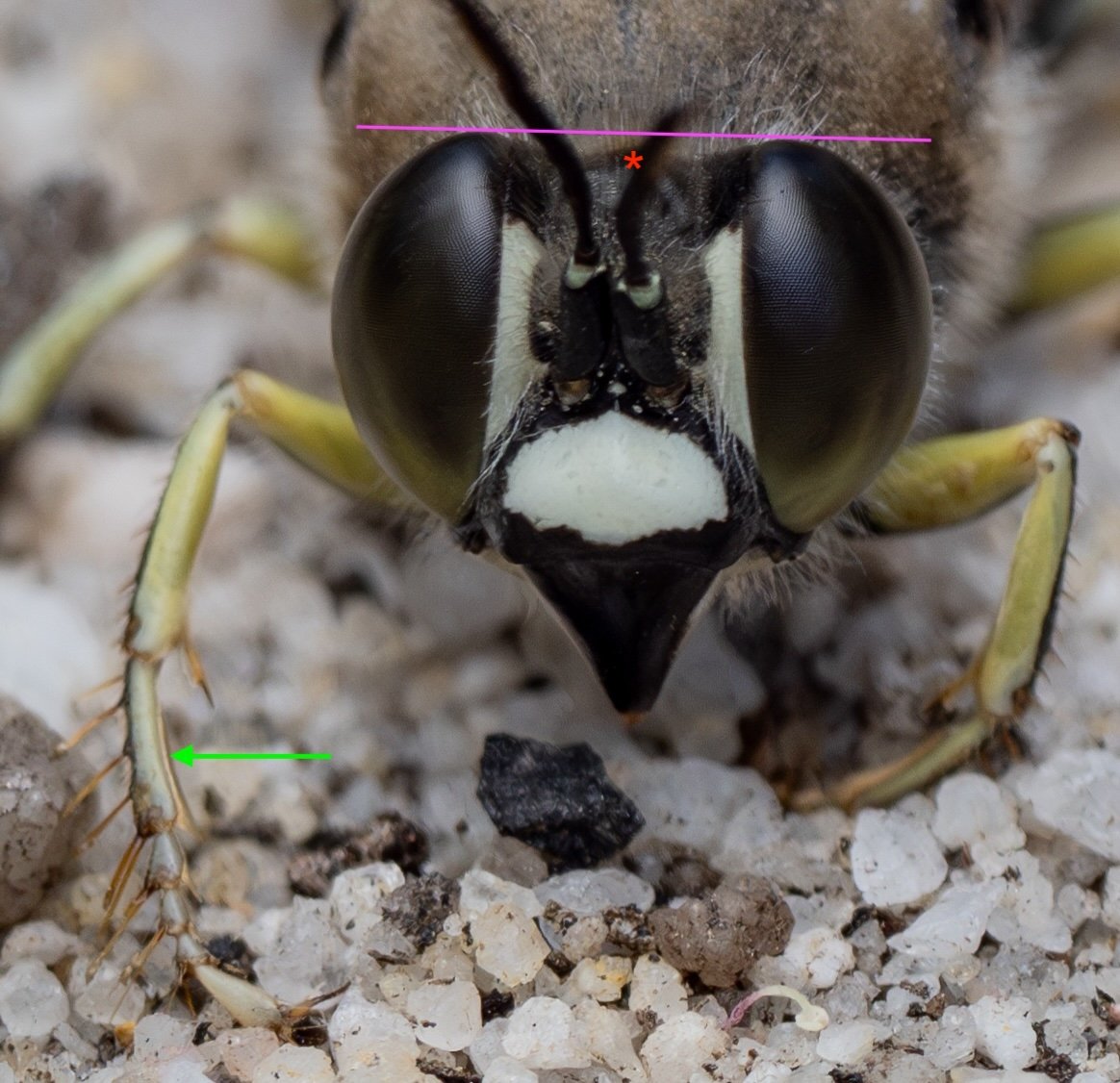
vertex, front basitarsus
In this species the vertex (star) is well below the level of the eye tops (line). The front basitarsus (arrow) is slender, narrowly margined black along the outer edge, and bears 6 slender, pale amber pecten spines. Note too that the following three tarsal segments are quite slender (not expanded or modified).
Bembix furcata

male antennae
In this species, flagellomere 5 (F5) is slightly excavated beneath, F6 more strongly so, and F7 spinose beneath (arrow). Compare to Fig. 134 (Evans & Matthews, 1973).
Bembix furcata
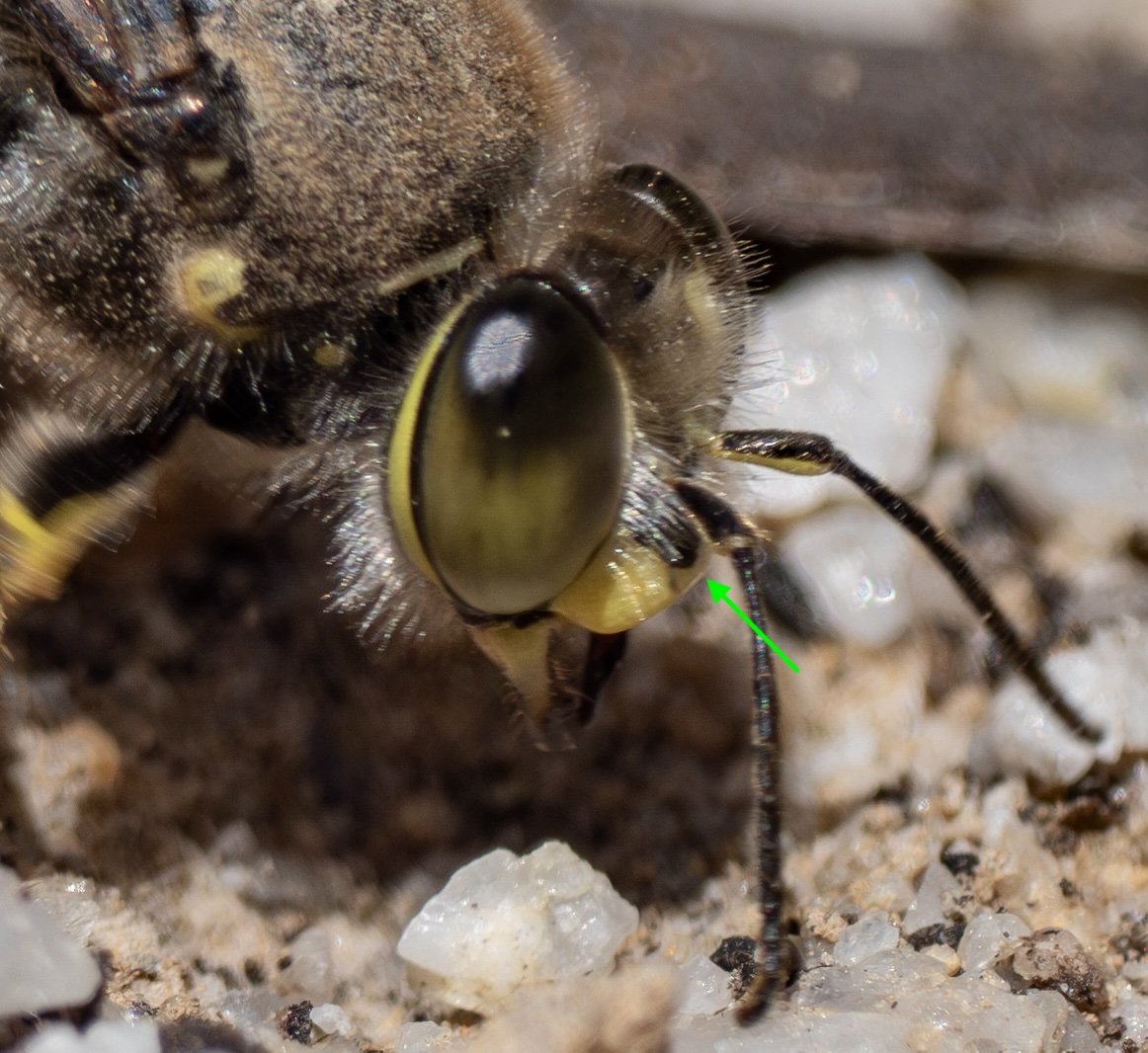
clypeus shape & colour
In this female, the clypeus (arrow) is very strongly protuberant and prominent laterally. It is bright yellow but with a large, black spot mediobasally.
Bembix furcata

tegula, mesoscutum, scape
Note the small lateral yellow streak on the mesoscutum, just above the tegula (star). The scape (arrow) is black above, yellow below.
The clypeus in this female is wholly yellow, without the black basal mark seen in some other individuals of the same species.
Bembix furcata
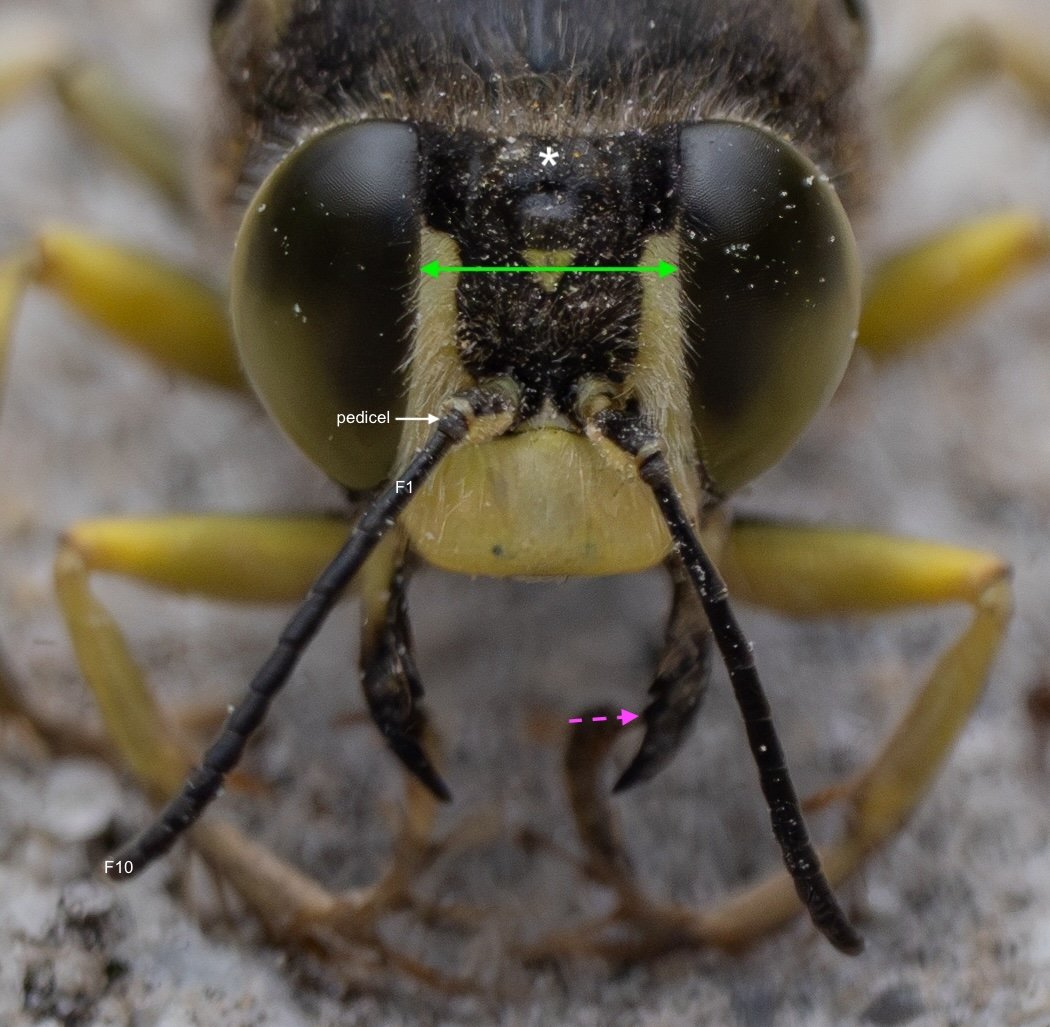
frons, vertex, flagellum
A full frontal view is necessary to assess the level of the vertex summit (star) with respect to the eye tops. Here the vertex is well below eye level.
Species vary in the width of the frons (double-headed arrow) relative to the eye height. In this female the frons is broad, the inner eye margins nearly parallel.
Differences in mandible shape between species are subtle, but do provide useful information. Here the mandible has a strong cutting edge (dotted arrow), described by Evans & Matthews as “an oblique cutting edge between the apex and the tooth on the inner margin.”
The number of antennal segments differs between the sexes. Females have just 10 flagellar segments, while males have 11.
Bembix furcata
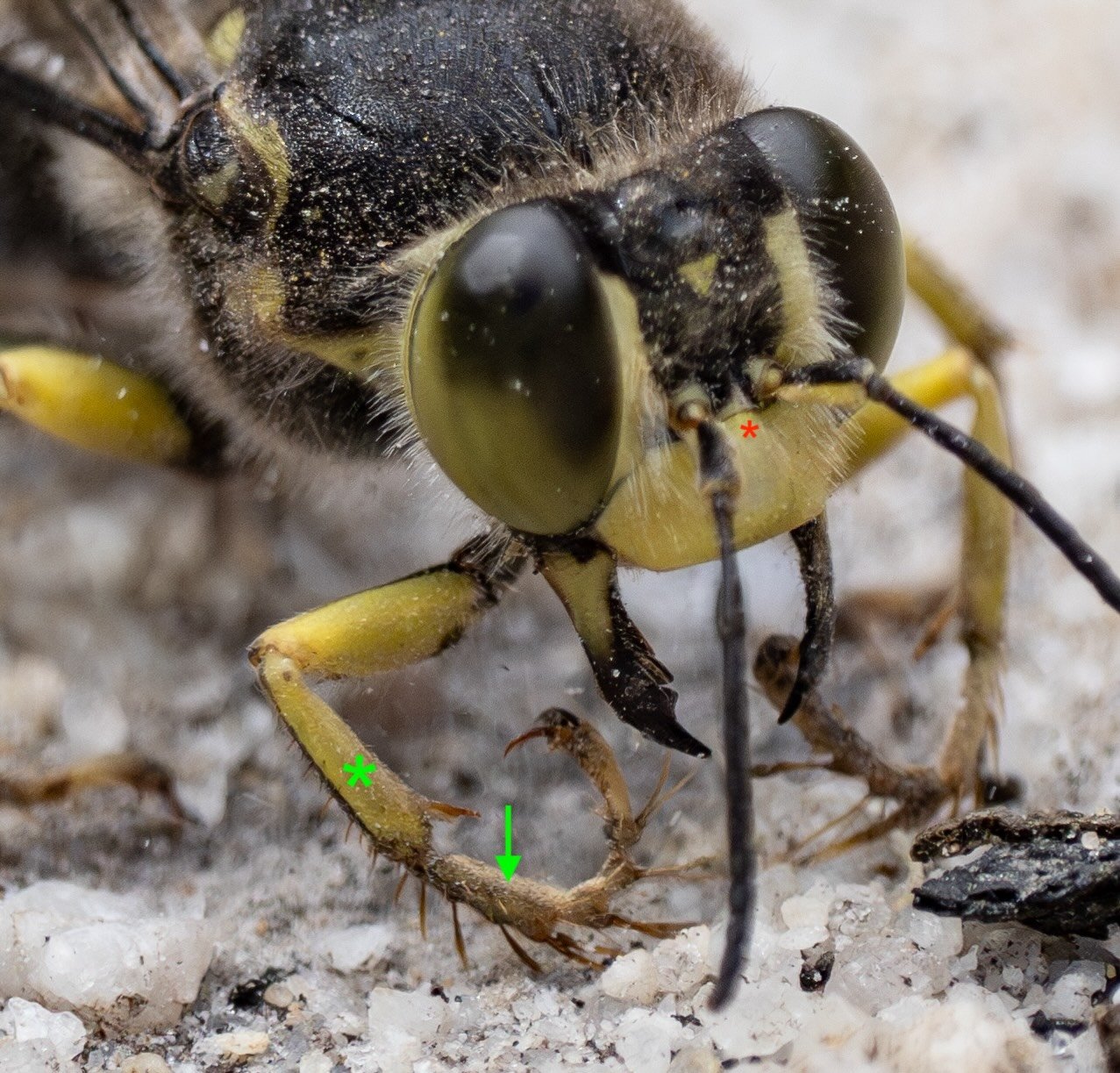
front tibia & basitarsus, clypeus
Of particular importance is the structure and colour of the front basitarsus (arrow), including the number of ‘pecten’ spines. In all Bembix species, tarsal segments 2-4 bear two pecten spines each but the number on the front basitarsus varies from 6 to 42.
Here there are 6 pecten spines on the front basitarsus, which is quite slender. Also of note is the darkened, slightly lobed outer edge.
The spur on the inner apex of the front tibia (green star) is distinctive in some species. Here it is unmodified, ‘simple’.
From this angle, the midline of the clypeus is visibly elevated (red star). The shape of the clypeus is a useful feature for distinguishing between species, although it can be difficult to discern in field photos.
Bembix furcata

front basitarsi, clypeus shape
An anterior view of the front legs displays the colour and number of pecten spines, and the shape of the basitarsus itself (arrows). In this female the basitarsus is long and slender (not broadly expanded), mostly yellow but with a darkened outer edge, weakly lobed at the base of the spines. The six spines are long, and amber in colour.
The clypeus in this female is elevated mediobasally (star).
Bembix furcata
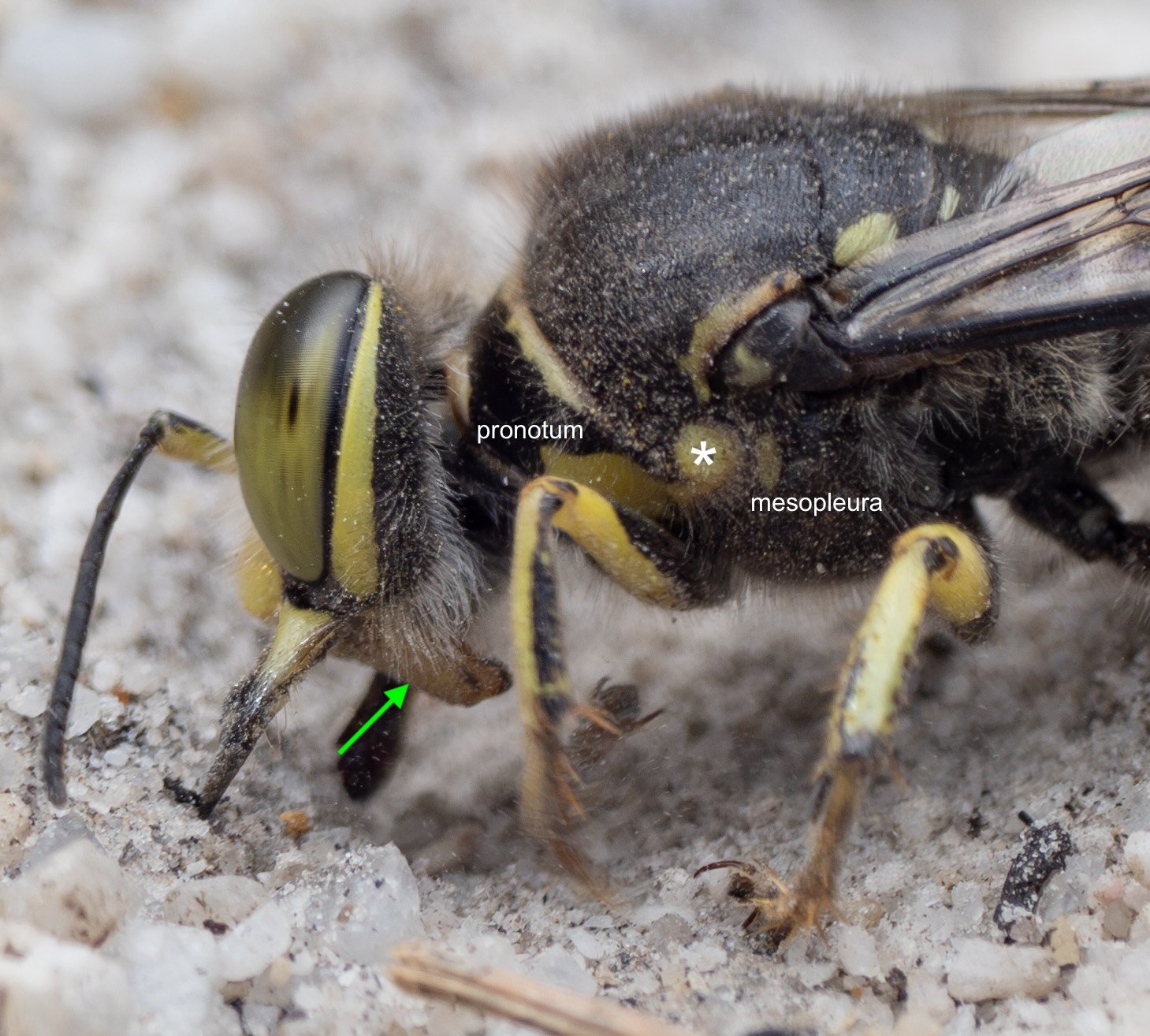
pronotum, mesopleura, labrum, mandibles
While colour patterning typically shows at least some variation within a species, it still provides a useful piece to the ID puzzle.
Two of the thoracic regions of note are the pronotum and the mesopleura. Note that in Bembix, the pronotum is much lower than the mesoscutum. It is often largely concealed in dorsal view, so lateral shots are helpful.
Note too the large pronotal lobe (star), which is extensively yellow in this species.
This angle also demonstrates why the labrum (arrow) can be difficult to see – it is often tucked away under the head.
When digging, females will usually have the mandibles open and forward of the labrum, making their colour easy to determine. In this female they meet the description of ‘yellow’, as the dark apex is universal in Bembix and so is not mentioned in the summary table of species descriptions.
Bembix furcata
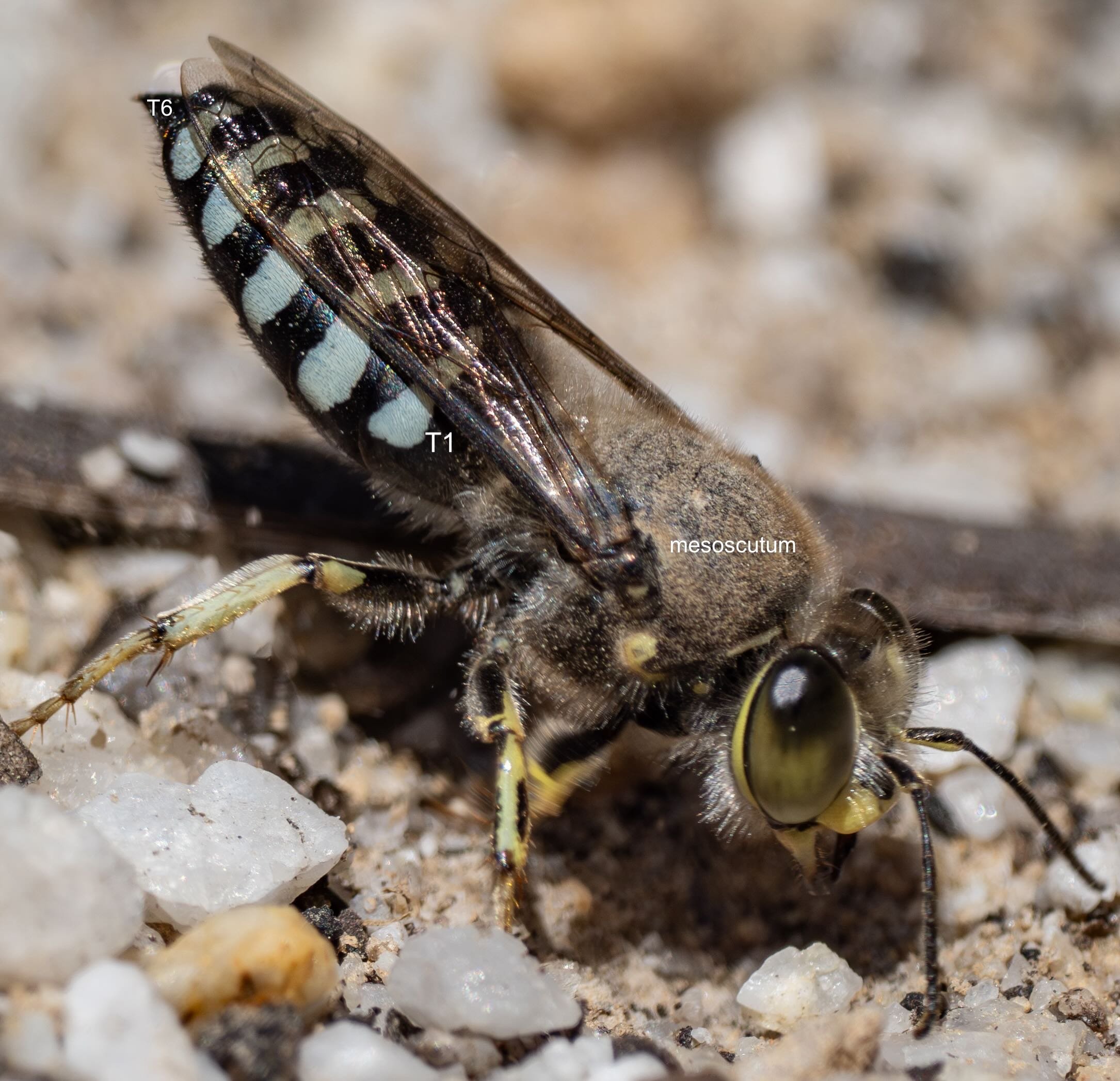
sand wasps indeed!
Many Bembix species are extensively, densely hairy (‘setose’). And these hairs readily trap sand and dirt, making it very difficult to see the colour pattern of the underlying structure. Just another of the challenges of species identification from field photos!
The six metasomal tergites confirm this as a female. Note how each tergite (the dorsal plate of the segment) extends laterally. The sternites (the equivalent ventral plates) are not visible from this angle.
Bembix furcata
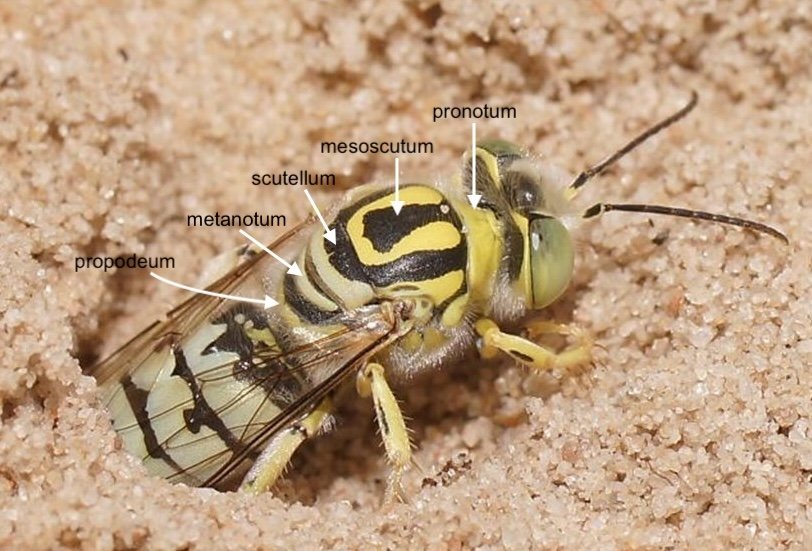
dorsal mesosoma ('thorax')
The major visible plates along the dorsal midline of the mesosoma are: pronotal collar (low in Bembix, relative to the mesoscutum); mesoscutum (often simply called the scutum); scutellum; metanotum (very short); and the propodeum. When the wings are in the usual position at rest, the propodeum is obscured, as it is in species with particularly dense setae (hairs).
The U-shaped yellow mark on the mesoscutum is referred to as a discal mark. In some individuals (and species), the discal marks are much narrower than this, and the segments of the U are often not connected.
Bembix variabilis
Image courtesy Reiner Richter
https://inaturalist.ala.org.au/observations/25727992
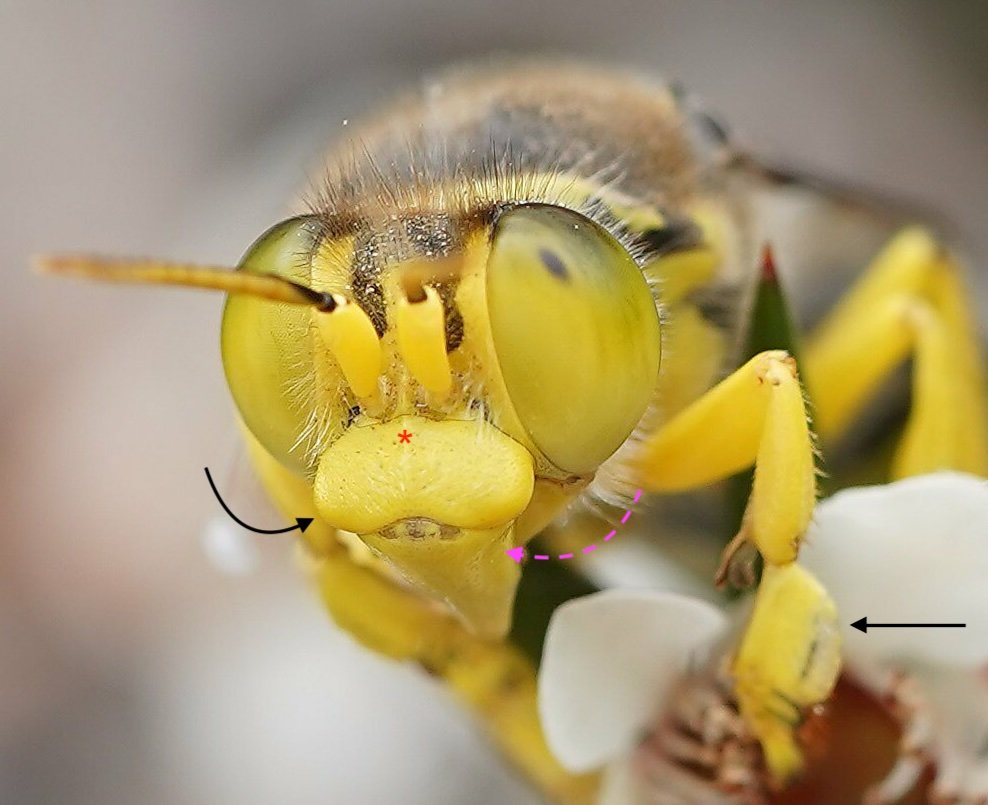
clypeus, labrum, front basitarsus
The features shown in this image are diagnostic for Bembix palmata males. The bright yellow clypeus is concave apically, has prominent round lobes laterally (curved solid arrow), and has a small median, basal ridge (star). The labrum is depressed near the base (dotted arrow), and also bright yellow. And the shape of the extremely broad front basitarsus (straight arrow) is unique.
Bembix palmata
Image courtesy Reiner Richter
https://inaturalist.ala.org.au/observations/147447501
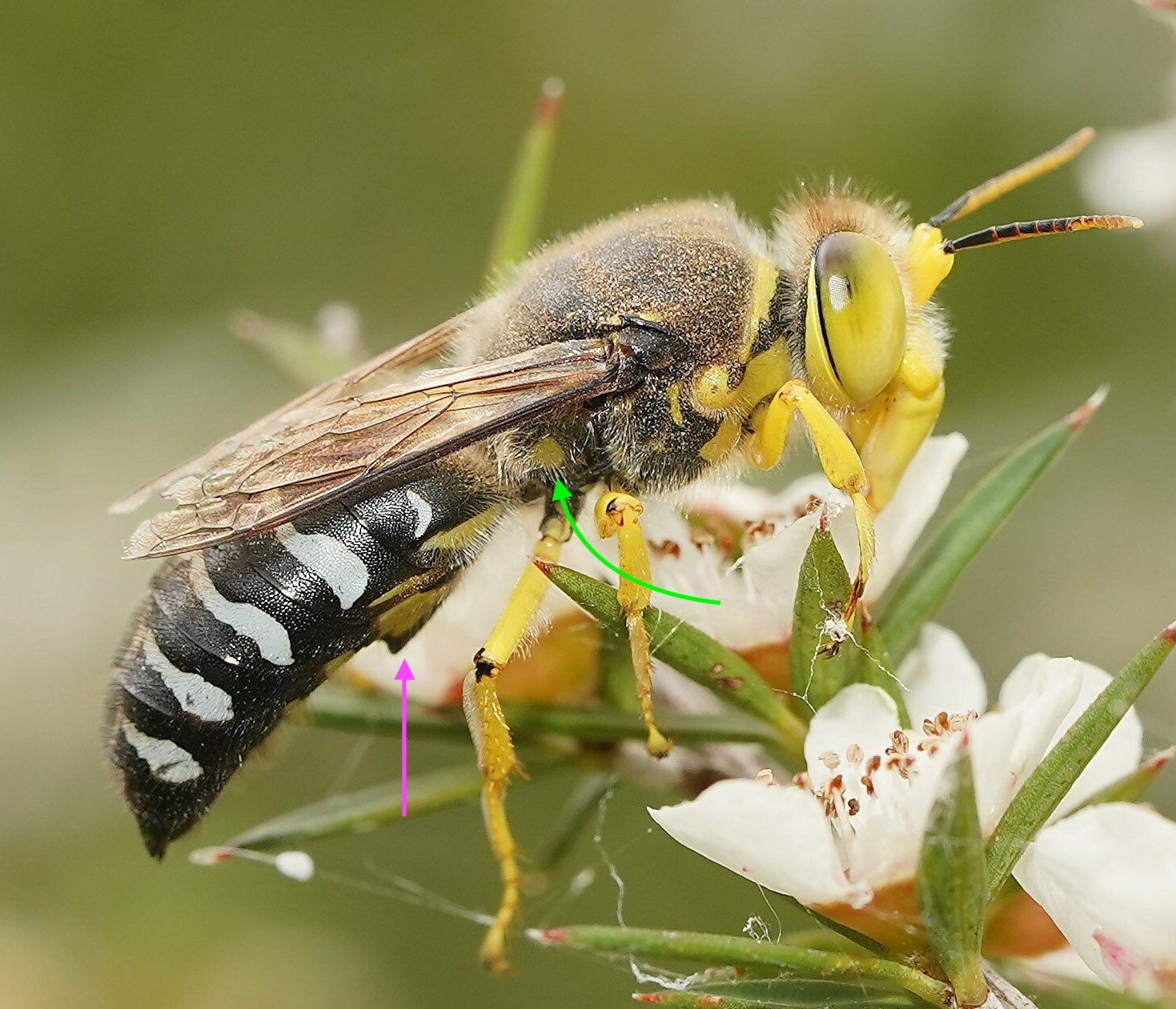
S2 process, propodeum markings
The best chance to see the sternal process of males is when they are feeding at flowers. This species has a high ridge on S2, right-angled at the apex (straight arrow).
The yellow marks on the sides of the propodeum (curved arrow) are also visible from this angle. Note too the yellow marks on the extreme lateral sides of T1, highlighting the extent to which the dorsal tergites wrap around ventrally.
Bembix palmata
Image courtesy Reiner Richter
https://inaturalist.ala.org.au/observations/147447501
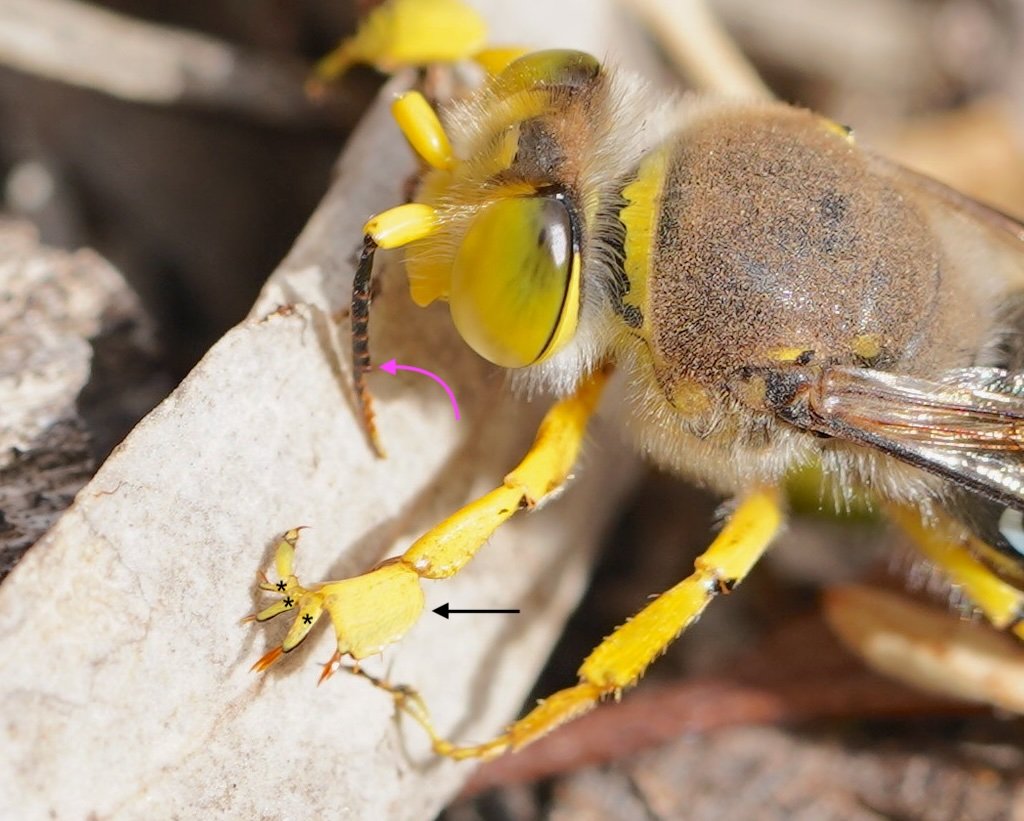
front basitarsus, male antenna
The uniquely shaped front basitarsus (straight arrow) of Bembix palmata is worth showing again. Note too the broadly expanded lobes of front tarsomeres 2, 3 and 4 (stars).
The shape of the male antenna is another feature that can helpful in species recognition. Modifications tend to start at flagellomere 5 (curved arrow), and in this species it is strongly spinose. Compare to Fig. 121 (Evans & Matthews, 1973).
Bembix palmata
Image courtesy Reiner Richter
https://inaturalist.ala.org.au/observations/105595939
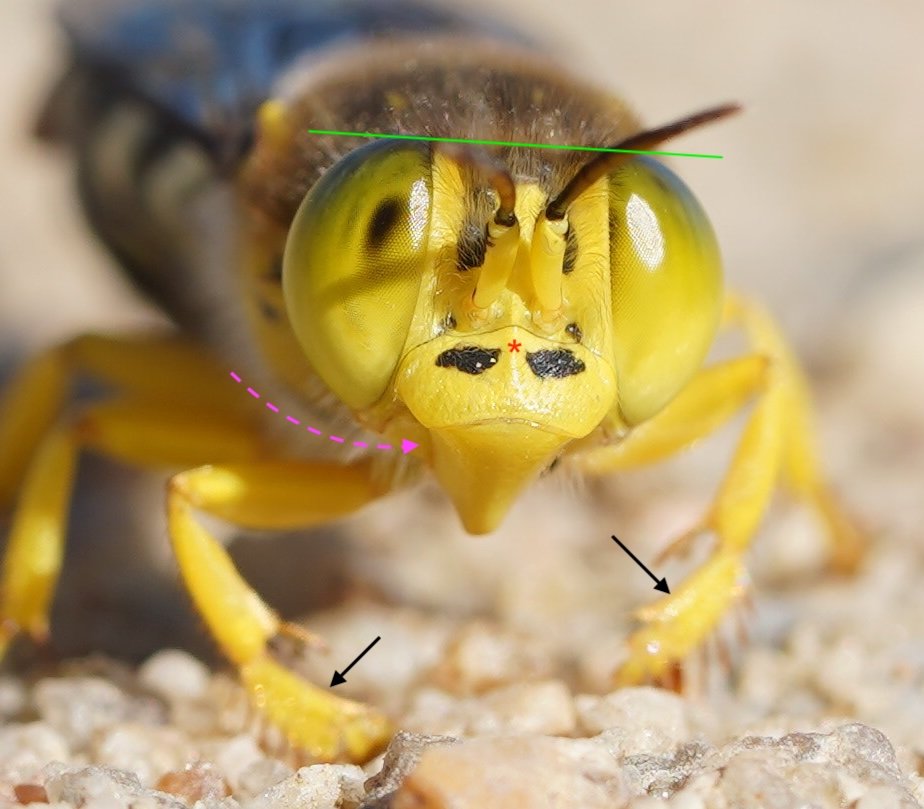
clypeus, labrum, front basitarsus, vertex
Although the diagnostic features in females of this species are not as pronounced as in the male, they are nevertheless enough for a species ID (when taken in combination with colour patterning).
As in the male:the clypeus is broad with a median carina basally (star); the labrum is depressed basally (dotted arrow); and the front basitarsi are expanded (solid arrows) as are the following tarsomeres.
Note too the vertex level with the eye tops (line). This is the not an uncommon condition, but it does contrast with some other extensively yellow species such as B. flavifrons.
Finally, in this species the female typically has a pair of black spots on the yellow clypeus. This too is a widespread pattern, seen in many species (yet often highly variable within a species).
Bembix palmata
Image courtesy Reiner Richter
https://inaturalist.ala.org.au/observations/66902356
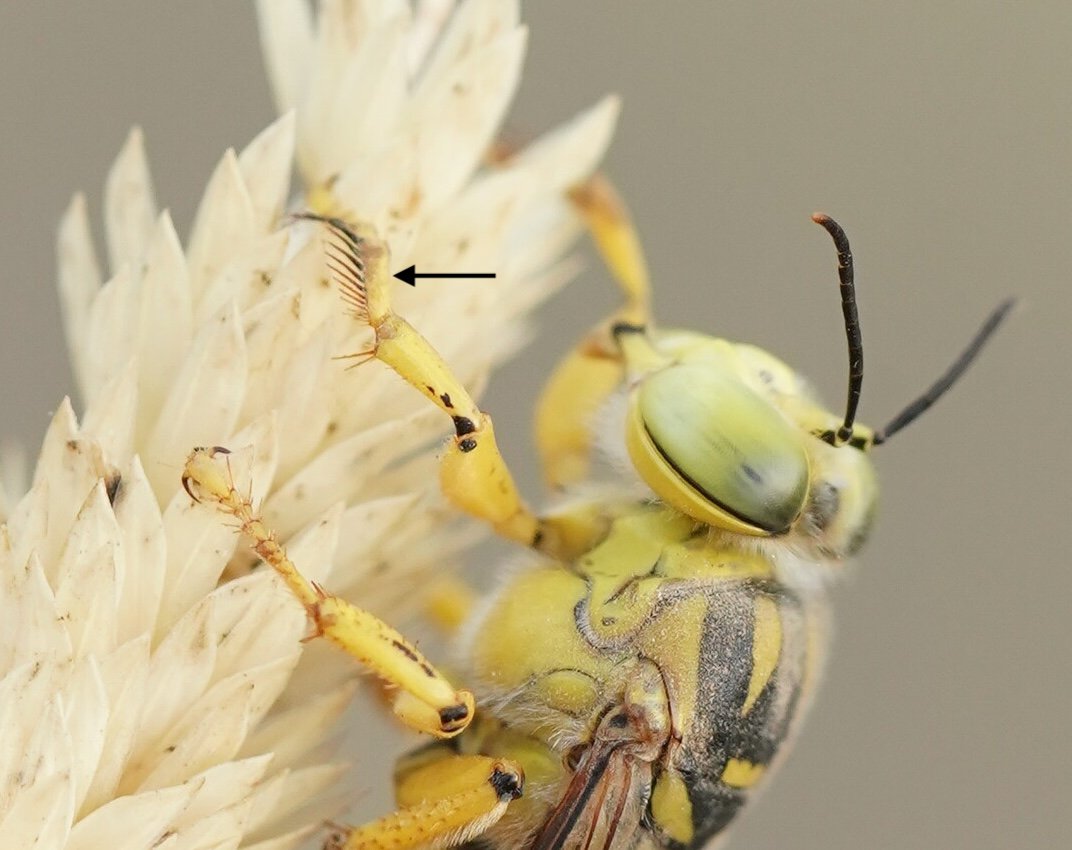
numerous pecten spines
The five species of the Pectinipes species group are characterised by their numerous pecten spines. All have at least 10, and some as many as 42! This female has 12 I can count, and probably more. Compare to Fig. 36 (Evans & Matthews, 1973).
Bembix flavifrons
Image courtesy Reiner Richter
https://inaturalist.ala.org.au/observations/150716071

pecten spines, clypeus, labrum, male antenna
The large number of pecten spines immediately identifies this as one of just three species (the Pectinipes species group). The highly distinctive shapes of the clypeus and labrum shape are diagnostic, and the strongly curved antennae provide further support.
Bembix flavifrons
Photographer: Mark Norman (Museums Victoria)
https://collections.museumsvictoria.com.au/specimens/2482511
Accessed 21 December 2025
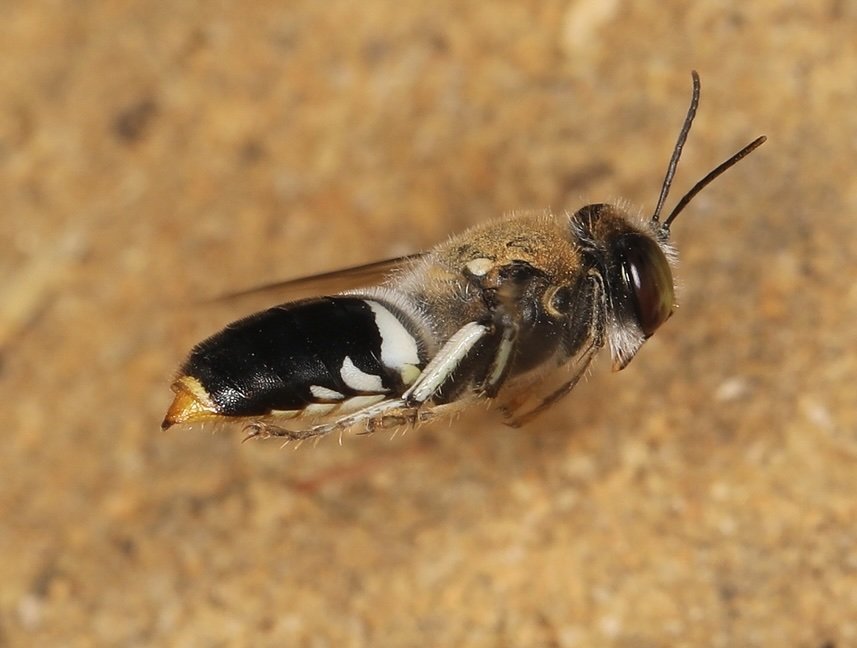
a unique colour pattern
There are few Australian Bembix that can be unambiguously identified to species level based on the colour pattern alone … but this one can! Commonly referred to as the ‘Panda Sand Wasp’, Bembix vespiformis is unmistakable. There is some variation … the apical segments are not always orange (particularly in the east), and T2-4 may be all black or have white spots. But the large, tapered white spots on T2 are a consistent feature.
Bembix vespiformis
Image courtesy Kerry Stuart
https://inaturalist.ala.org.au/observations/198711178
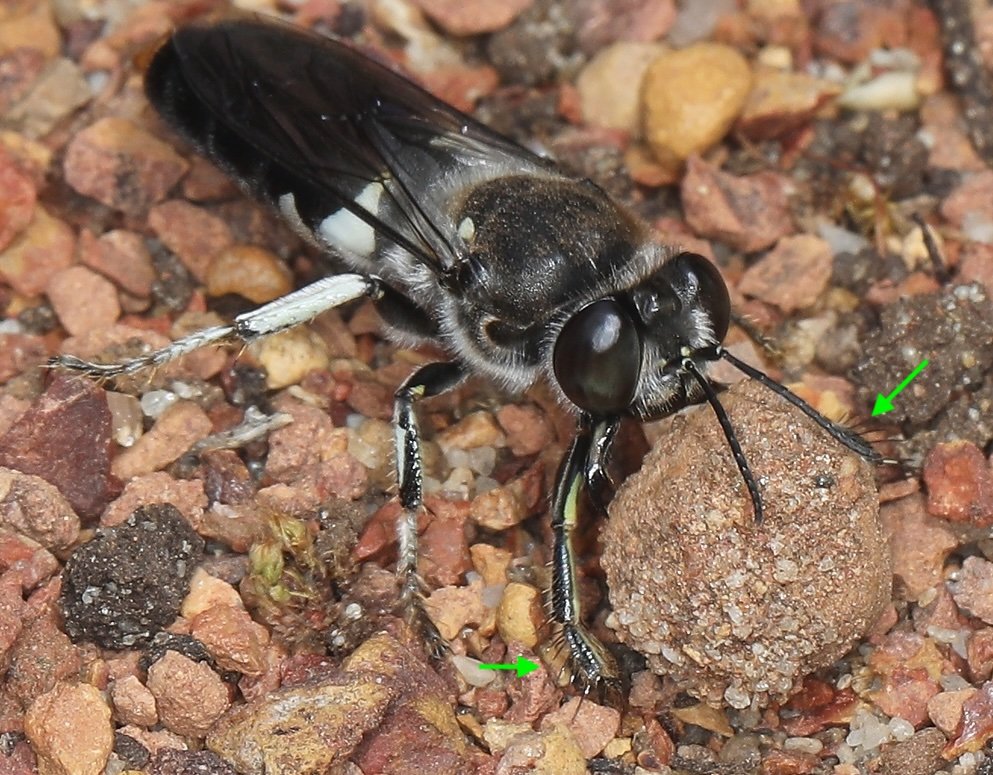
long, dark pecten spines
Despite the distinctive colour pattern, I like to check as many other features as possible against a putative species description. For example, here the colour of the mandibles, legs, mesoscutum all fit with Bembix vespiformis … as do the 7 long, dark pecten spines on each of the front basitarsi (arrows).
Note that this is one of many Bembix species widely distributed across continental Australia.
Bembix vespiformis
Image courtesy Kerry Stuart
https://inaturalist.ala.org.au/observations/195650631
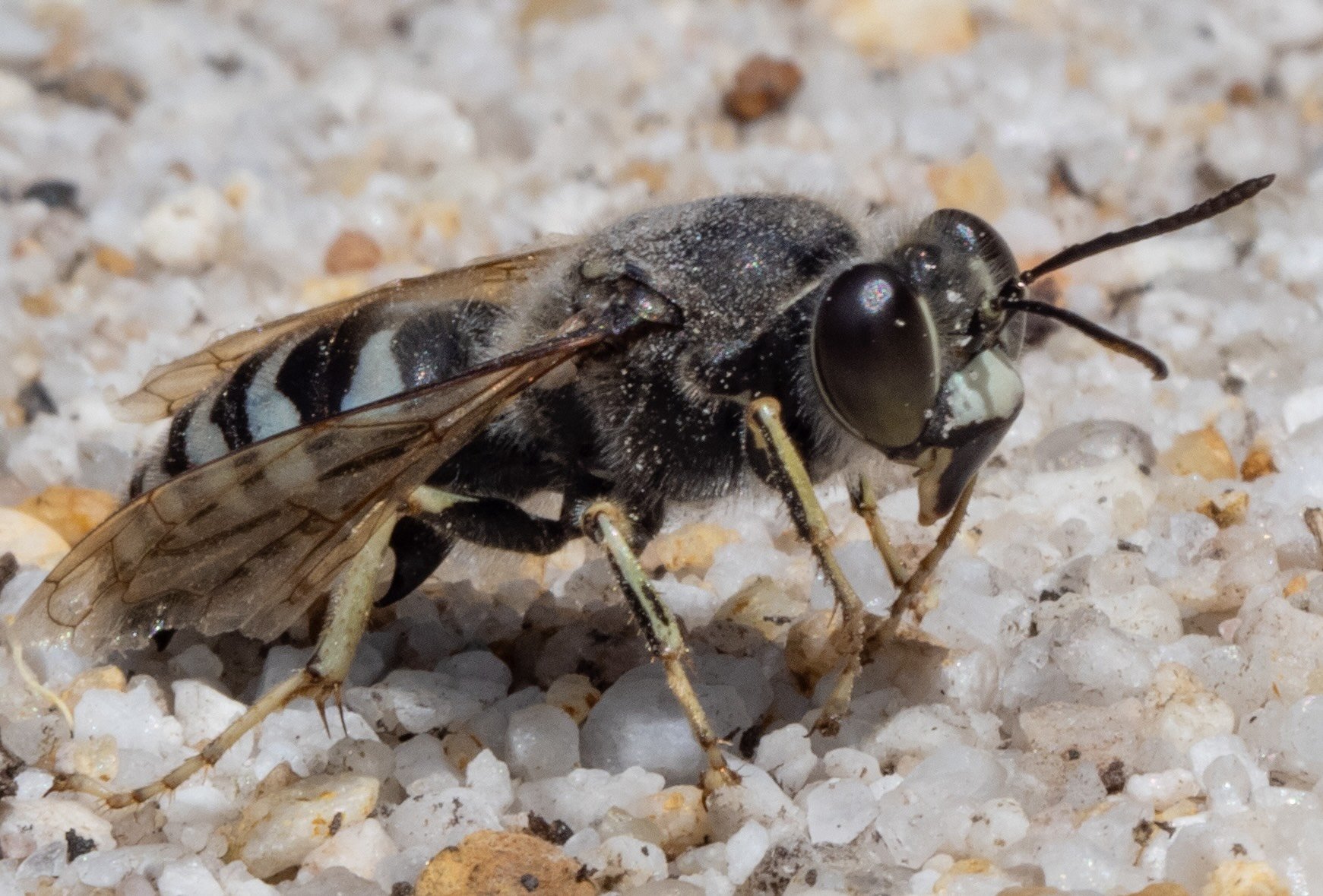
B. furcata
NOTE: this is the only species known from Tasmania
- clypeus white, bordered black; labrum black
- centre of vertex well below level of eye tops
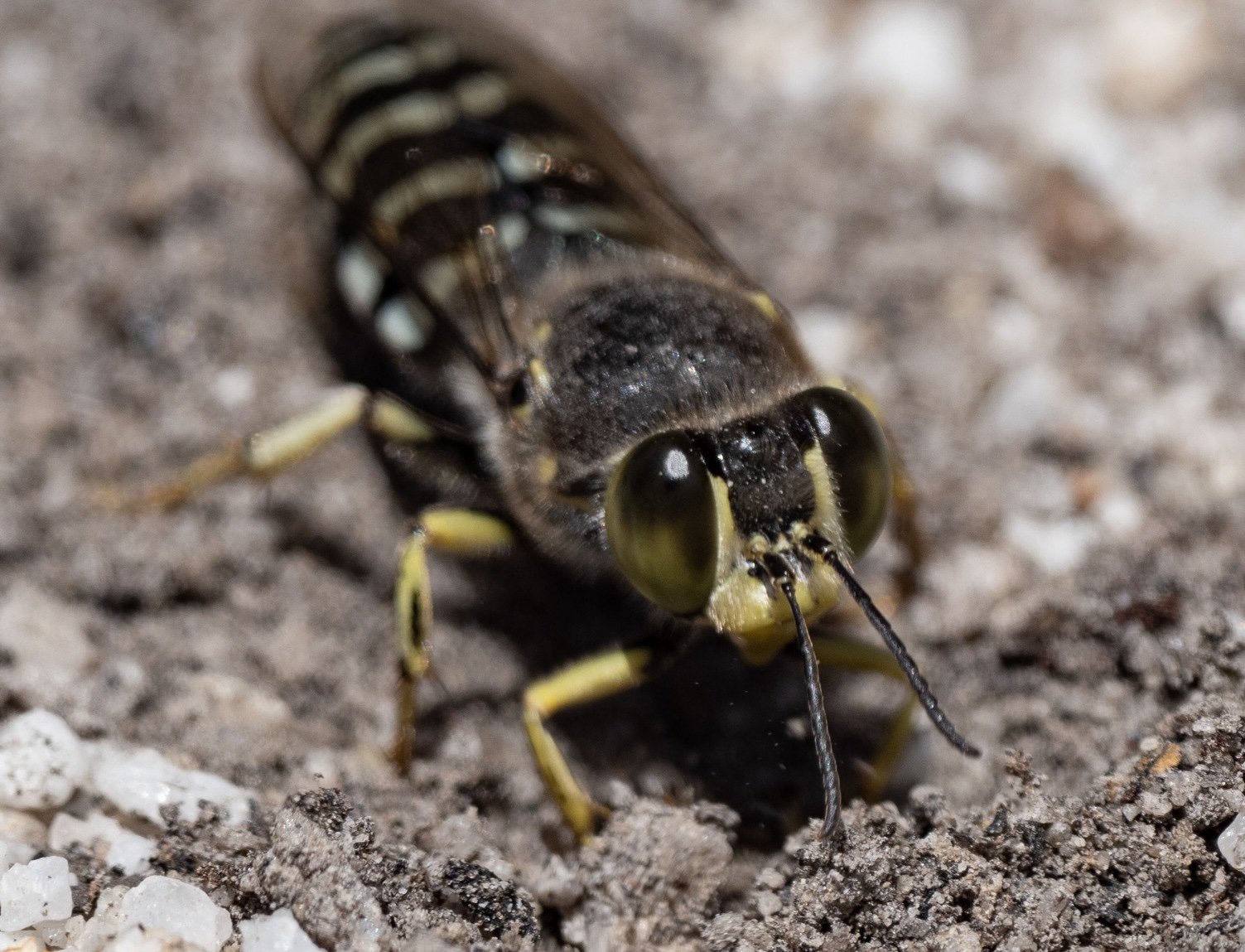
B. furcata
Note: this is the only species known from Tasmania
- clypeus prominent laterally
- centre of vertex well below level of eye tops
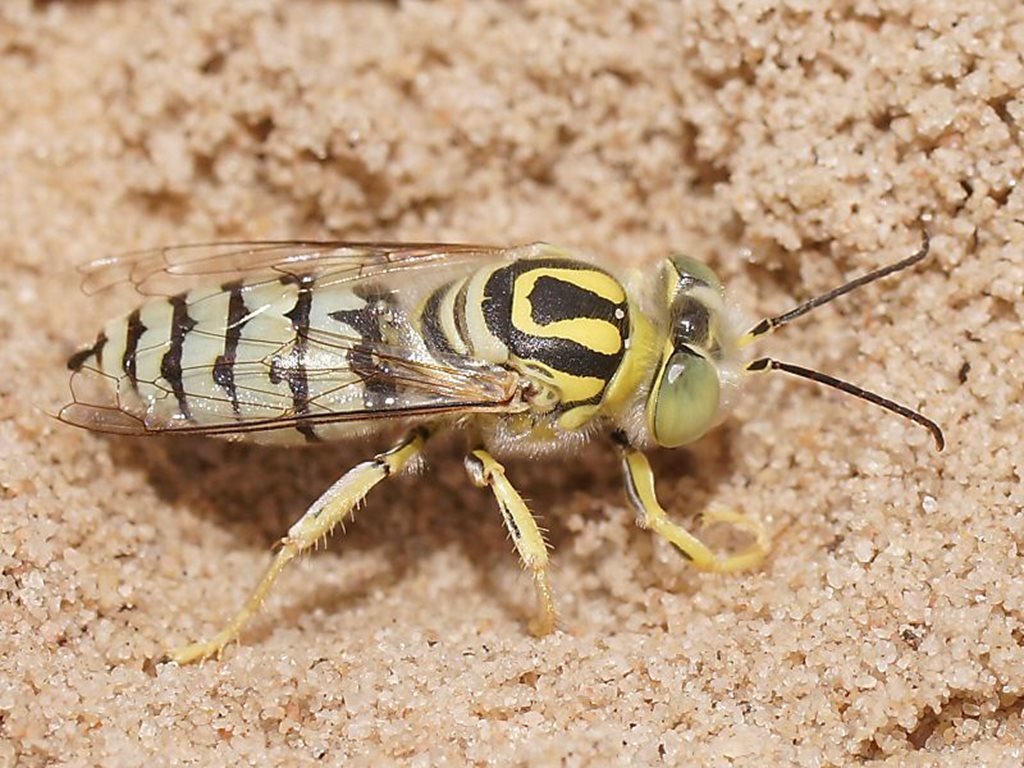
B. variabilis
- band on T1 has an angular median notch (in addition to the pair of more lateral emarginations)
- colour of metasomal bands is typically cream or off-white (but may be brighter yellow in some individuals)
https://inaturalist.ala.org.au/observations/25727992
(image courtesy Reiner Richter)

B. variabilis
- discal markings on mesoscutum may be a pair of large yellow streaks and a transverse yellow mark behind (as here), or these may be thicker and connected to form a solid U-shape
https://inaturalist.ala.org.au/observations/107168910
(image courtesy Hauke Koch)

B. lamellata
- tricoloured mandible
- large (broad?) S2 projection
- S6 elevated, angulate apically
- unusually dense & long pale hairs, including on T1 & propodeum
- metasoma mainly black, limited white markings
https://inaturalist.ala.org.au/observations/145146372
(image courtesy Brian Byrnes)

B. lamellata
- central vertex above eye level
- clypeus & labrum wholly pale
- large yellow spot on mesopleura
https://inaturalist.ala.org.au/observations/145157864
(image courtesy Brian Byrnes)
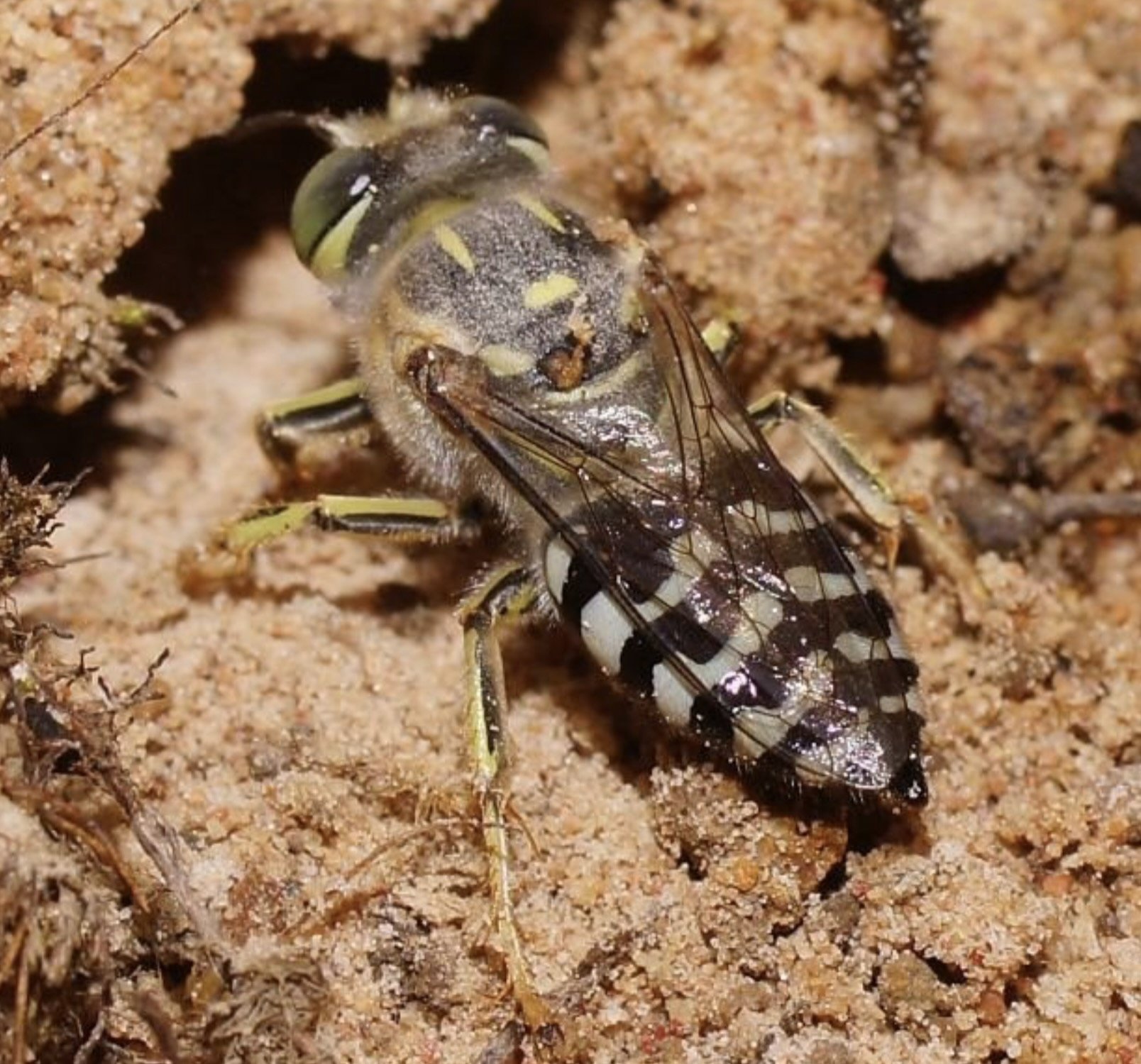
B. littoralis (?)
- white to yellow bands on T1-T5, interrupted medially & each with strong, anterior emarginations
- centre of vertex not strongly depressed (cf. B. furcata)
Despite being a common, widespread species, I’m not yet completely confident in my ability to recognise it. It remains a work-in-progress.
https://inaturalist.ala.org.au/observations/25720932
(image courtesy Reiner Richter)

B. palmata
- front basitarsus much expanded from base; broad & flat: following tarsomeres also expanded on the outer margin
- clypeus prominent laterally, forming round & projecting lobes
- bright yellow legs, clypeus, labrum
https://inaturalist.ala.org.au/observations/256325551
(image courtesy Graham & Maree Goods)
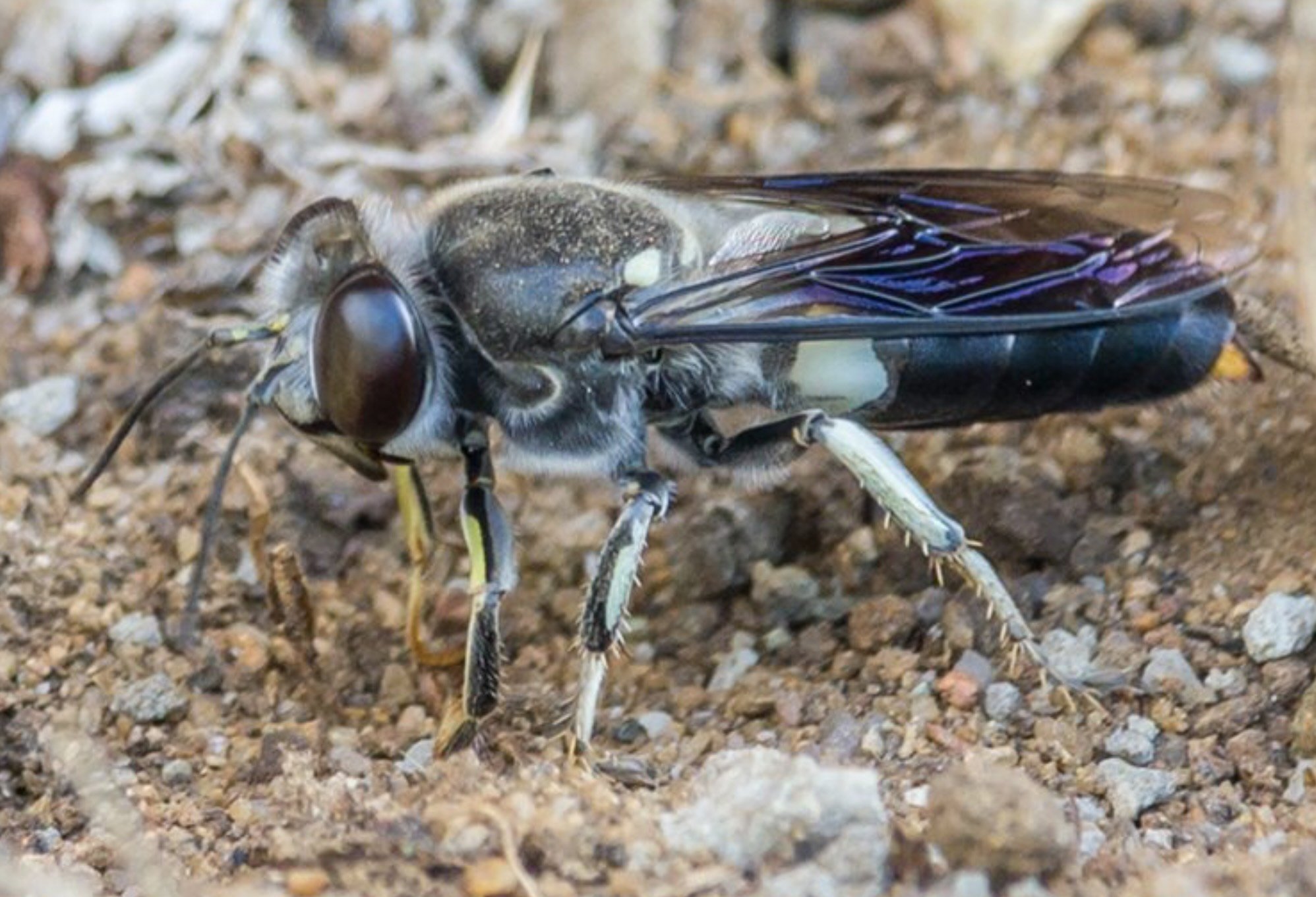
B. vespiformis
- metasoma with strongest white marks on T1, tapered medially; following tergites mostly black
- apical tergite may be orange
https://inaturalist.ala.org.au/observations/25832854
(image courtesy Teale Britstra)

B. trepida
- clypeus protuberant but flattened apically, & with oblique black markings basally
- front basitarsus slender, & with darkened lobes at base of each pecten spine
- T1 has yellow spot at extreme side, in addition to white marking more dorsally
- S1-5 with yellow lateral spots
https://inaturalist.ala.org.au/observations/203204274
(image courtesy Phil Warburton)

B. flavifrons
- numerous pecten spines on front basitarsus (at least 16)
- expanded front basitarsus
- clypeus shape diagnostic, with pair deep lateral grooves and strongly elevated medially and laterally
- labrum also unusual form, with median basal sulcus and strongly elevated laterally
- mid tibia much expanded from a slender base
Photographer: Mark Norman (Museums Victoria)
https://collections.museumsvictoria.com.au/specimens/2482511
Accessed 21 December 2025

B. littoralis
Note: this is one of the most common and widespread species … yet it remains an identification challenge. The variation in colour is “almost beyond description”, and they are rather generalist in their morphology. However, it can be done. With caution. This one I’m confident of, having obtained a specimen for a closer look. In particular, note:
- broad and high vertex, strongly elevated centrally
- slender mandibles
- in this dark variant, the combination of minimal mesoscutal markings with narrow metasomal bands (in contrast with coast B. variabilis, which have broad metasomal bands even when the mesoscutum is entirely black)
For full details:
https://southernforestlife.net/notes/2025/bembix-littoralis

































